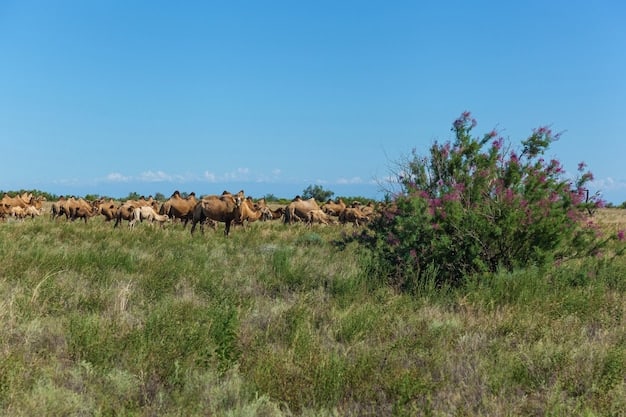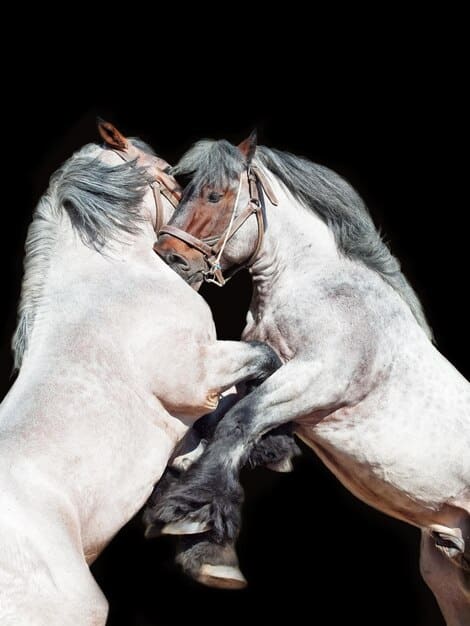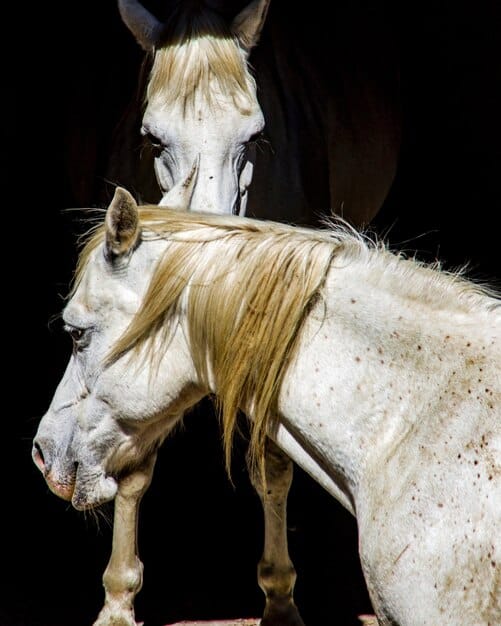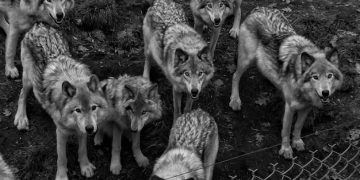Equine Social Hierarchy: Understanding Dominance in Horse Herds

Equine Social Hierarchy is the structured system within horse herds, defining dominance and submission through interactions that ensure herd stability and resource allocation.
Understanding the equine social hierarchy: Understanding dominance and submission in horse herds is crucial for anyone working with horses, whether as a trainer, owner, or researcher. This complex structure dictates how horses interact, compete for resources, and maintain stability within their herd.
What is Equine Social Hierarchy?
Equine social hierarchy refers to the pecking order established within a group of horses. This hierarchy influences access to resources like food, water, and shelter, as well as mating opportunities. Recognizing this structure is essential for horse management and welfare.
The establishment and maintenance of this hierarchy are achieved through a variety of behaviors, ranging from subtle gestures to overt aggression. Understanding these behaviors is key to interpreting horse interactions and ensuring a harmonious environment.
Dominance and Submission
At the core of the equine social hierarchy are the concepts of dominance and submission. Dominant horses have priority access to resources and exert control over other herd members. Submissive horses, on the other hand, defer to dominant individuals to avoid confrontation.
These roles are not static and can shift over time due to factors such as age, health, and individual personality. The dynamic nature of the hierarchy requires constant negotiation and readjustment among herd members.
- Dominance: The ability to control resources and direct the behavior of others.
- Submission: Deference to dominant individuals to avoid conflict.
- Dynamic: The hierarchy is not fixed, changing as horses mature and their relationships evolve.

In conclusion, understanding the principles of dominance and submission is fundamental to grasping the intricacies of equine social structure. These behaviors play a critical role in maintaining order and stability within the herd, impacting the well-being of all its members.
Factors Influencing Hierarchy
Several factors contribute to the formation and maintenance of equine social hierarchies. These include age, sex, size, and temperament. Each of these elements plays a unique role in determining a horse’s position within the herd.
Studying these factors provides valuable insights into the dynamics of horse herds and can inform management strategies aimed at promoting harmony and reducing conflict.
Age and Experience
Older, more experienced horses often hold higher positions in the hierarchy. Their accumulated knowledge of the environment and social dynamics provides an advantage in resource acquisition and conflict resolution.
However, age is not the sole determinant of dominance. Young, physically strong horses can challenge older individuals, leading to shifts in the established order.
Sex and Hormones
Sex plays a significant role in the equine social hierarchy, particularly during breeding season. Stallions typically compete for dominance to gain access to mares, leading to intense displays of aggression.
Mares also establish their own hierarchies, often based on factors such as age, size, and reproductive status. These hierarchies influence access to resources and social support within the herd.
- Stallions: Compete for dominance and access to mares.
- Mares: Establish hierarchies based on age, size, and reproductive status.
- Hormones: Influence aggression and competitive behavior, particularly during breeding season.
Ultimately, a comprehensive understanding of how these factors interplay is essential for predicting and managing social dynamics within horse herds. By considering age, sex, hormones, and more, caretakers can better foster a healthy and stable environment for these animals.
Dominance Behaviors
Dominance behaviors in horses are varied and subtle, but they effectively signal a horse’s position within the social hierarchy. Recognizing these behaviors is key to understanding herd dynamics.
Identifying these signals is crucial for horse owners and handlers, as it allows them to anticipate conflicts and ensure the safety and well-being of their animals.
Physical Displays
Physical displays of dominance include actions such as biting, kicking, charging, and pinning ears. These behaviors are often used to assert control over space, resources, or other herd members.
However, overt aggression is typically reserved for situations where subtle cues are insufficient to establish dominance. Horses often prefer to avoid direct confrontation to minimize the risk of injury.
Subtle Signals
Subtle signals of dominance include staring, head raising, and body positioning. These behaviors communicate a horse’s intent to control or influence the actions of others.
Submissive horses often respond to these cues by lowering their heads, turning away, or moving out of the dominant horse’s path. This helps to maintain social order and prevent conflict.
- Biting and Kicking: Overt displays of aggression to assert control.
- Staring and Head Raising: Subtle signals of intent to dominate.
- Body Positioning: Using body language to control space and movement.

In summary, recognizing both the overt and subtle dominance behaviors in horses is critical to interpreting their interactions and ensuring a safe and harmonious environment for all herd members. By understanding these signals, caretakers can proactively manage social dynamics and mitigate potential conflicts.
Submission Behaviors
Submission behaviors are equally important in maintaining social harmony within a horse herd. These actions signal a horse’s acceptance of a subordinate role and help to avoid conflict.
Identifying these behaviors allows observers to understand how horses negotiate their social relationships and maintain a stable hierarchy.
Body Language
Submissive horses typically exhibit body language that signals deference to dominant individuals. This includes lowering the head, softening the gaze, and turning away from the dominant horse.
These behaviors communicate a willingness to yield resources or territory, reducing the likelihood of confrontation. Submissive horses may also display appeasement gestures, such as licking or grooming dominant individuals.
Vocalization
Vocalization can also play a role in submission. Submissive horses may emit soft whinnies or sighs to signal their acceptance of a subordinate role.
Conversely, dominant horses may use loud snorts or squeals to assert their authority and reinforce the hierarchy. The interplay of vocal and physical cues helps to maintain order and prevent conflict within the herd.
- Lowering the Head: A common signal of deference and submission.
- Softening the Gaze: Avoiding direct eye contact to reduce tension.
- Appeasement Gestures: Licking or grooming to appease dominant individuals.
Understanding the range of submission behaviors in horses is essential for anyone working with or observing these animals. These signals provide valuable insights into the complex social dynamics that govern horse herds and can inform management strategies aimed at promoting welfare and reducing stress.
Benefits of a Stable Hierarchy
A stable equine social hierarchy offers numerous benefits to the herd, promoting efficiency, reducing conflict, and enhancing overall well-being.
Understanding these benefits underscores the importance of allowing horses to establish and maintain their natural social structures whenever possible.
Resource Management
A stable hierarchy streamlines resource management by establishing clear priorities for access to food, water, and shelter. Dominant horses have first access, while submissive individuals wait their turn.
This reduces competition and ensures that the most vital resources are allocated efficiently. It also minimizes the risk of injury associated with fighting over resources.
Conflict Reduction
A well-defined hierarchy minimizes conflict by reducing uncertainty about social roles and expectations. Horses understand their position within the herd and behave accordingly.
This reduces the frequency and intensity of aggressive interactions, creating a more harmonious environment. It also frees up energy for other activities, such as grazing and socializing.
- Efficient Resource Allocation: Dominant horses have priority access.
- Minimized Competition: Clear social roles reduce fighting.
- Enhanced Herd Harmony: Less aggression promotes overall well-being.
Ultimately, the presence of a stable equine social hierarchy yields significant benefits for the entire herd. From streamlining resource management to reducing conflict, these structures contribute to a healthier, more relaxed, and more efficient environment for all horses involved.
Managing Hierarchy in Domestic Settings
Managing equine social hierarchy in domestic settings requires careful consideration of the horses’ natural behaviors and needs. Creating an environment that allows horses to express their social instincts can improve their well-being.
Providing adequate space, resources, and social opportunities can help promote a stable and harmonious herd dynamic, even in managed environments.
Providing Adequate Space
Providing adequate space is essential for allowing horses to establish and maintain their social hierarchy. Insufficient space can lead to increased competition and aggression.
Ideally, horses should have access to large paddocks or pastures where they can move freely and avoid constant close contact with other herd members. This allows them to express their natural behaviors and negotiate their social relationships.
Ensuring Sufficient Resources
Ensuring sufficient resources, such as food and water, is also critical for managing hierarchy in domestic settings. Limited resources can exacerbate competition and lead to conflict.
Providing multiple feeding stations and water sources can help reduce competition and ensure that all horses have access to what they need. It’s also important to monitor individual horses to ensure that submissive individuals are not being deprived of resources by dominant herd members.
- Adequate Space: Allows horses to establish social distance.
- Sufficient Resources: Reduces competition for food and water.
- Careful Monitoring: Ensures submissive horses are not deprived.
In brief, effectively managing the equine social hierarchy in domestic settings involves creating an environment that respects and accommodates the horses’ inherent social behaviors. By providing ample space, ensuring sufficient resources, and carefully monitoring herd dynamics, caretakers can foster a healthier and more harmonious environment for these animals.
| Key Concept | Brief Description |
|---|---|
| 🐴 Dominance | Control of resources and behavior in the herd. |
| 🤝 Submission | Deference to dominant horses to avoid conflict. |
| 🌱 Factors | Age, sex, size, and temperament affect hierarchy. |
| 🛡️ Management | Space and resources help balance herd dynamics. |
Frequently Asked Questions
▼
A stable hierarchy minimizes conflict and streamlines access to vital resources, ensuring the well-being of the entire herd by reducing constant competition.
▼
Dominant horses use physical displays (biting, kicking) and subtle cues (staring, head raising) to control space and influence the behavior of other herd members.
▼
Submissive horses lower their heads, soften their gaze, and move out of the dominant horse’s path, signaling their willingness to yield resources or territory.
▼
Adequate space enables horses to establish social distance and reduces the risk of increased competition and aggression among herd members due to limited space.
▼
Providing multiple feeding and watering stations ensures that all horses have access to necessary resources, which decreases competition and elevates the overall herd’s comfort.
Conclusion
Understanding the equine social hierarchy is essential for anyone working with horses. By recognizing dominance and submission behaviors and managing the environment to support a stable hierarchy, we can promote the well-being of these magnificent animals and foster harmonious herd dynamics.





